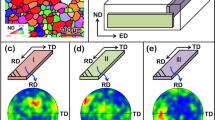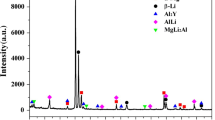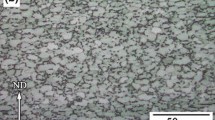Abstract
In the current study, the effect of deformation mode (i.e., symmetric vs asymmetric rolling) on the extent of grain refinement and texture development in Ti-6Al-4V was examined through warm rolling of a martensitic starting microstructure. During rolling, the initial martensitic lath structure was progressively fragmented, primarily through continuous dynamic recrystallization. This eventually led to an ultrafine-grained (UFG) microstructure composed of equiaxed grains with a mean size of 180 to 230 nm, mostly surrounded by high-angle grain boundaries. Depending on the rolling reduction and deformation mode (symmetric and asymmetric), the rolled specimens displayed different layer morphologies throughout the specimen thickness: a fully UFG surface layer, a partial UFG transition layer, and a partially fragmented lath interior layer. Due to a higher level of effective strain and continuous rotation of the principle axis, asymmetric rolling resulted in a greater extent of grain refinement compared with symmetric rolling at a given thermomechanical condition. A bulk UFG structure was successfully obtained using 70 pct asymmetric rolling. In addition, the rolling texture exhibited various characteristics throughout the thickness due to a different combination of shear and compressive strains. Principally, the basal texture component was displaced from the normal toward rolling direction during asymmetric rolling, differing from the symmetric rolling textures.











Similar content being viewed by others
References
L.R. Saitova, H.W. Höppel, M. Göken, I.P. Semenova and R.Z. Valiev: Int. J. Fatigue, 2009, vol. 31, pp. 322-31.
A.V. Sergueeva, V.V. Stolyarov, R.Z. Valiev and A.K. Mukherjee: Mater. Sci. Eng. A, 2002, vol. 323, pp. 318-25.
Y. Estrin and A. Vinogradov: Acta Mater., 2013, vol. 61, pp. 782-817.
Y.G. Ko, W.S. Jung, D.H. Shin and C.S. Lee: Scripta Mater., 2003, vol. 48, pp. 197-202.
S. Zherebtsov, A. Mazur, G. Salishchev and W. Lojkowski: Mater. Sci. Eng. A, 2008, vol. 485, pp. 39-45.
S.V. Zherebtsov, G.A. Salishchev, R.M. Galeyev, O.R. Valiakhmetov, S.Y. Mironov and S.L. Semiatin: Scripta Mater., 2004, vol. 51, pp. 1147-51.
N. Tsuji and T. Maki: Scripta Mater., 2009, vol. 60, pp. 1044-49.
D. Yang, P. Cizek, P.D. Hodgson and C.E. Wen: Scripta Mater., 2010, vol. 62, pp. 321-24.
S. Zherebtsov, E. Kudryavtsev, S. Kostjuchenko, S. Malysheva and G. Salishchev: Mater. Sci. Eng. A, 2012, vol. 536, pp. 190-96.
Q. Chao, P.D. Hodgson and H. Beladi: Metall. Mater. Trans. A, 2014, vol. 45A, pp. 2659-71.
C.H. Park, J.H. Kim, J.T. Yeom, C.S. Oh, S.L. Semiatin and C.S. Lee: Scripta Mater., 2013, vol. 68, pp. 996-99.
H. Matsumoto, L. Bin, S.H. Lee, Y. Li, Y. Ono and A. Chiba: Metall. Mater. Trans. A, 2013, vol. 44A, pp. 3245-60.
I. Weiss, F.H. Froes, D. Eylon and G.E. Welsch: Metall. Trans. A, 1986, vol. 17A, pp. 1935-47.
T. Seshacharyulu, S.C. Medeiros, J.T. Morgan, J.C. Malas and W.G. Frazier: Scripta Mater., 1999, vol. 41, pp. 283-88.
S.L. Semiatin, V. Seetharaman and I. Weiss: Mater. Sci. Eng. A, 1999, vol. 263, pp. 257-71.
C.H. Park, Y.G. Ko, J.W. Park and C.S. Lee: Mater. Sci. Eng. A, 2008, vol. 496, pp. 150-58.
S.L. Semiatin and T.R. Bieler: Acta Mater., 2001, vol. 49, pp. 3565-73.
E.B. Shell and S.L. Semiatin: Metall. Mater. Trans. A, 1999, vol. 30A, pp. 3219-29.
S.I. Oh, S.L. Semiatin and J.J. Jonas: Metall. Trans. A, 1992, vol. 23A, pp. 963-75.
D. Orlov, A. Pougis, R. Lapovok, L.S. Toth, I.B. Timokhina, P.D. Hodgson, A. Haldar and D. Bhattacharjee: Metall. Mater. Trans. A, 2013, vol. 44A, pp. 4346-59.
M.H. Cai, S. Singh Dhinwal, Q.H. Han, Q. Chao and P.D. Hodgson: Mater. Sci. Eng. A, 2013, vol. 583, pp. 205-09.
K.H. Kim and D.N. Lee: Acta Mater., 2001, vol. 49, pp. 2583-95.
J. Sidor, A. Miroux, R. Petrov and L. Kestens: Acta Mater., 2008, vol. 56, pp. 2495-5507.
B. Beausir, S. Biswas, D.I. Kim, L.S. Tóth and S. Suwas: Acta Mater., 2009, vol. 57, pp. 5061-77.
X. Huang, K. Suzuki, A. Watazu, I. Shigematsu and N. Saito: Mater. Sci. Eng. A, 2008, vol. 488, pp. 214-20.
M. Diot, J.J. Fundenberger, M.J. Philippe, J. Wégria and C. Esling: Scripta Mater., 1998, vol. 39, pp. 1623-30.
Z. Li, L. Fu, B. Fu and A. Shan: Mater. Sci. Eng. A, 2012, vol. 558, pp. 309-18.
S. Zaefferer: Mater. Sci. Eng. A, 2003, vol. 344, pp. 20-30.
O. Engler and V. Randle: Introduction to Texture Analysis : Macrotexture, Microtexture, and Orientation Mapping, 2nd ed., Taylor and Francis, Hoboken, 2009.
Y.N. Wang and J.C. Huang: Mater. Chem. Phys., 2003, vol. 81, pp. 11-26.
P. Ari-Gur and S.L. Semiatin: Mater. Sci. Eng. A, 1998, vol. 257, pp. 118-27.
M. Peters and G. Lütjering: Proc. of 4th Int. Conf. on Titanium, Kyoto, Japan, H. Kimura and O. Izumi, eds., TMS-AIME, Warrendale, PA, 1980, pp. 925–35.
K. Morii, H. Mecking, G. Lütjering and Y. Nakayama: Scripta Metall., 1986, vol. 20, pp. 1795-800.
M.J. Philippe, C. Esling and B. Hocheid: Texture Microstruct., 1988, vol. 7, pp. 265-301.
M.J. Philippe, M. Serghat, P. Van Houtte and C. Esling: Acta Metall. Mater., 1995, vol. 43, pp. 1619-30.
D. Dunst, R. Dendievel and H. Mecking: Mater. Sci. Forum, 1994, vol. 157-162, pp. 665-72.
G.C. Obasi, S. Birosca, D.G. Leo Prakash, K. Quinta da Fonseca and M. Preuss: Acta Mater., 2012, vol. 60, pp. 6013-24.
S. Roy and S. Suwas: Metall. Mater. Trans. A, 2013, vol. 44A, pp. 3303-21.
M. Peters, A. Gysler and G. Lütjering: Metall. Trans. A, 1984, vol. 15A, pp. 1597-1605.
M.A.W. Lowden and W.B. Hutchinson: Metall. Trans. A, 1975, vol. 6A, pp. 441-48.
H. Mecking and D. Dunst: Mater. Sci. Eng. A, 1994, vol. 175, pp. 55-62.
H. Beladi, Q. Chao and G.S. Rohrer: Acta Mater., 2014, vol. 80, pp. 478-89.
N. Stanford and P.S. Bate: Acta Mater., 2004, vol. 52, pp. 5215-24.
G.C. Obasi, S. Birosca, J. Quinta da Fonseca and M. Preuss: Acta Mater., 2012, vol. 60, pp. 1048-58.
S.B. Kang, B.K. Min, H.W. Kim, D.S. Wilkinson and J. Kang: Metall. Mater. Trans. A, 2005, vol. 36A, pp. 3141-49.
P.J. Hurley, B.C. Muddle and P.D. Hodgson: Metall. Mater. Trans. A, 2001, vol. 32A, pp. 1507-17.
H. Beladi, G.L. Kelly and P.D. Hodgson: Int. Mater. Rev., 2007, vol. 52, pp. 14-28.
T.R. Bieler and S.L. Semiatin: Int. J. Plast., 2002, vol. 18, pp. 1165-89.
M.A. Imam and C.M. Gilmore: Metall. Trans. A, 1983, vol. 14A, pp. 233-40.
W.F. Hosford and R.M. Caddell: Metal Forming: Mechanics and Metallurgy, 4th ed., Cambridge University Press, Cambridge, 2011.
Acknowledgments
This research was supported by grants through the Australian Research Council including an ARC Laureate Fellowship (P.D.H.). The authors would also like to thank Professor Bevis Hutchinson and Professor John Duncan for valuable discussions.
Author information
Authors and Affiliations
Corresponding author
Additional information
Manuscript submitted June 2, 2015.
Appendix
Appendix
The level of effective plastic strain can be generally estimated using the equivalent von Mises strain (ε VM) given by:
where ε i=x, y, z , γ ij=yz, xz, xy represent the normal and shear strain in x, y, and z directions of an object. During a rolling process, the x, y, and z refers to RD, TD, and ND, respectively. For conventional symmetric rolling, the plastic region is thinned by the compressive strain in ND and free to expand in RD. The lateral expansion in TD is restricted by non-deforming material in forward and backward direction of roll gap and the friction between the plate and rolls.[50] Hence, the deformation state can be approximately reduced to a two-dimensional plane strain, where ε x = −ε z , ε y = 0, and γ yz = γ xy = 0. The form of Eq. [1] can be reduced to
In the current study, a shear strain in the RD–ND plane (γ xz ) was taken into account for asymmetric rolling and the surface region of symmetric rolling due to the friction between the plate and rolls,[22] whereas no shear strain was considered at the mid-thickness of symmetrically rolled plate. The compressive strain ε z can be readily calculated through the rolling thickness reduction. However, the estimation of shear strain γ xz is more complicated as the frictional shear stress and resultant plastic deformation depends on the geometry of rolls and plate, rolling conditions such as rolling speed, reduction, and lubrication, as well as the elastic/plastic response of the deforming material under a specific condition, etc. Here, a method proposed by Berusir et al.[24] was employed to calculate the shear coefficient (K) through measuring the shear angle (θ f ) of some vertical inserts in the as-rolled plates. The shear coefficient can be determined by
where h i and h f represent the initial and final thickness of plates subjected to rolling, respectively. The stress/strain state during the rolling process is expected to be well presented using this method, as probably all external and internal factors affecting the shear and normal strains are reflected through the shear angle of vertical inserts made of the identical material. By combining Eqs. [2] and [3], the effective strain can be calculated:
Apart from the current method, Kang et al.[45] proposed an equation to determine the true shear strain based on a geometrical analysis. The shear strain can be expressed as
where R 1 and R 2 are the radii of larger and smaller rolls, respectively. Sidor et al.[23] computed the effective strain during asymmetric rolling of an aluminum alloy using Eqs. [2] and [5]. However, several assumptions were taken for this geometric calculation method, which may lead to overestimation of the shear strain.[23,45] In addition, this method only allows the estimation of the total imposed strain for a whole specimen whereas our approach enables a more precise measurement of the effective strain for a particular layer throughout the plate thickness. Figure 10(c) illustrated the equivalent strain calculated using each method for different rolling conditions.
Rights and permissions
About this article
Cite this article
Chao, Q., Hodgson, P.D. & Beladi, H. Microstructure and Texture Evolution During Symmetric and Asymmetric Rolling of a Martensitic Ti-6Al-4V Alloy. Metall Mater Trans A 47, 531–545 (2016). https://doi.org/10.1007/s11661-015-3211-y
Published:
Issue Date:
DOI: https://doi.org/10.1007/s11661-015-3211-y




